So the USA raised the retirement age from 64 to 67. Phew! It’s a good thing that I applied for it early. Damn! I’d be forever waiting for this fucking stipend otherwise. Sheech!
Now this…

Freedom of speech and press. No longer exists in the USA.
Period.
Europe tries to break Russia and China apart
It failed bigly.
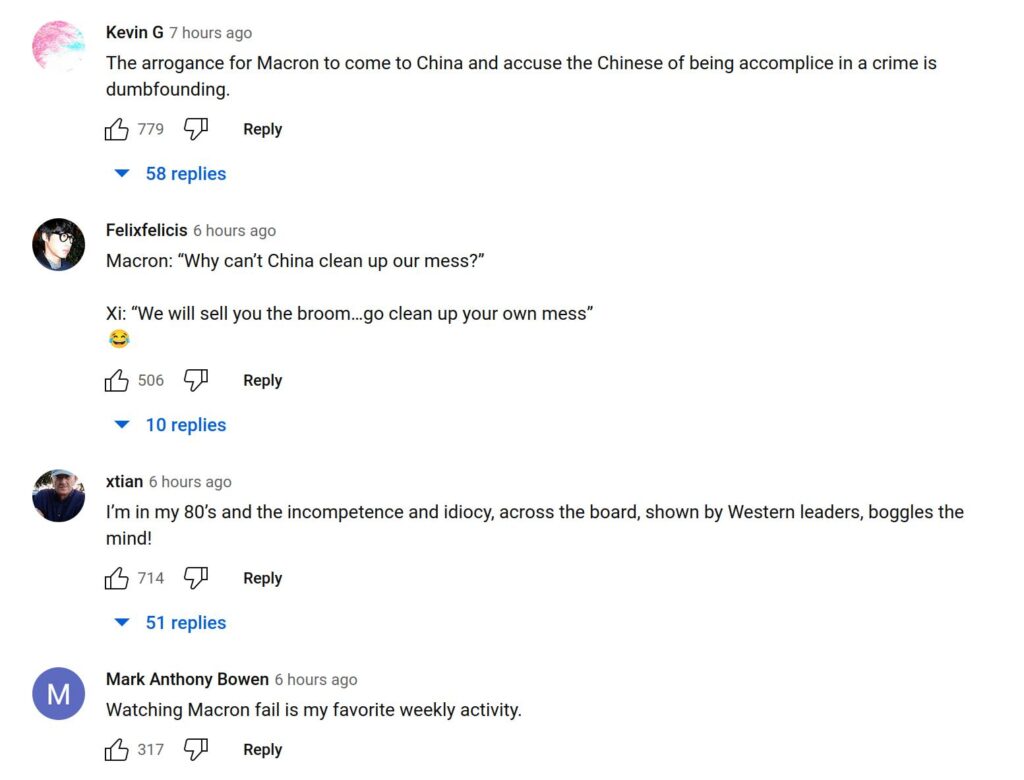
An outstanding video!
The idiot will not stop…
EU to sanction home appliance exports to Russia?
Memo to Frau von der Leyen: Pull the plug on it
Since the start of the Russo-Ukrainian conflict in February 2022, the European Union has ratified 10 sanctions packages designed to undermine Russia’s capacity to wage war in Ukraine. Now, kitchen appliances are in the EU’s crosshairs.
British newspaper The Telegraph, claiming to have seen a confidential EU report, says Brussels is considering imposing trade restrictions “on countries helping Russia acquire [microchips] in washing machines and used cars to repair its battle-stricken fleet of tanks.”
Thus the EU is threatening to apply secondary sanctions – that is, penalties on persons and entities outside of the EU’s legal jurisdiction – on countries in Central Asia and the Caucasus.
When weighing the imposition of secondary sanctions, EU policy should be guided by realpolitik and strategic thinking rooted in common sense, rather than by ideology and moral indignation, whether feigned or sincerely meant.
For the EU to impose trade restrictions on other countries on the suspicion that they are reselling significant quantities of home appliances to Russia, which then strips them for their microchips, is potentially destructive of the West’s strategic interests across Middle Eurasia.
The evidence suggests that harvesting microchips contained in home appliances sourced in “secondary” countries, usually for military use, is an exceedingly rare occurrence. It is cost-ineffective and unnecessary to boot, because EU countries have not seriously clamped down on the export of EU-sourced processors used in refrigerators, washing machines and other such appliances.
EU (and G7) leaders should think twice before insisting that other countries – mainly in Central Asia and the Caucasus – expend energy and resources on so dubious an undertaking with potentially negative political consequences for themselves.
To sanction – and possibly punish – consumers and traders of home appliances is unreasonable and impractical in view of the easy accessibility of military-grade microchips on the market already.
Moreover, these chips are nearly impossible to track after delivery to distributors or resellers in third counties around the world. What’s more, by the end 2022, Qingdao Haier Ltd, a Chinese enterprise, had become the largest maker of washing machines and refrigerators in Russia.
(By the way, General Electric sold its 100-year-old appliances business to Haier in 2016.)
Common sense
Then there is this consideration, which should occur to anyone with an ounce of common sense: Why would the Russian military – or any military for that matter – go through all the trouble and expense of finding, importing or buying vast numbers of washers and refrigerators when it is easier and cheaper to order large quantities of microchips from the many companies and resellers hawking them worldwide, including chips compatible with Russia’s own global positioning system, GLONASS?
A Forbes magazine article titled “Is Russia really buying home appliances to harvest computer chips for Ukraine-bound weapons systems?” states that “these kinds of chips [for drones] have long been widely available to civilian users on the global market, and Ukrainian authorities say at least six US companies produce GLONASS-compatible chips.”
And these components are “not under embargo,” says Sven Etzold, the senior director of business marketing at U-Blox: “They are usually for civil usage and can be officially bought through a distributor.”
Chris Miller, a fellow at the American Enterprise Institute and specialist in semiconductors, said recently, “My feeling is that most of the chips that Russia is accessing today for integrating into military systems are not coming via this route [home appliances].
“We should probably assume that Russia is going to find ways to get access to lower-tech chips simply because they’re widely available,” he said.
Chip suppliers
According to an investigative report in January summarized in the Netherlands Times, “Several million microchips produced by Dutch manufacturers, including NXP and Nexperia, wound up in Russia last year in shipments that were handled by resellers after sanctions were in place as a consequence of Russia’s invasion of Ukraine.”
One can only assume that Russia has installed some of these Dutch microchips in military hardware.
“Key technology [used in drones for satellite navigation] is European and American,” reports CBS Evening News, and “the chips are still flowing” into Russia and available in the global market. The Columbia Broadcasting System singled out U-Blox, a Swiss company, and Maxim and Microchip, two US producers of microprocessors, whose chips could well have ended up in Russia.
In view of all this, it doesn’t seem to make sense to threaten Armenia, Kazakhstan or Turkey, for example, with sanctions of one kind or another when the availability of new lower-tech chips is widespread. Secondary sanctions on home appliances seem uncalled for.
EU-Russian trade
Al Jazeera reported last month that “in total, the EU imported €171 billion (US$186 billion) worth of goods from Russia starting from March 2022 until the end of January 2023.”
According to Eurostat, the EU statistics office, the European Union has posted a net trade deficit in the billions of dollars with Russia each month since January 2021. This means that significant business between Russia and the EU continues despite all the chatter to the contrary.
Europe’s double standards are clear for everyone to see. While Brussels wants to call on non-EU countries to cut their trade with Russia, the EU continues to trade with Moscow.
Start with Western firms
Nearly 9% of Western firms have divested from Russia since the onset of the Russo-Ukrainian conflict, according to Simon J Evenett, professor of international trade and economic development at the University of St Gallen, and Niccolò Pisani, professor of strategy and international business at IMD Business School in Switzerland: “Of the total of 1,404 EU and G7 companies with commercially active equity investments in Russia before the invasion of Ukraine … by the end of November 2022, a total of 120 (8.5%) [had] actually left.”
European Commission President Ursula von der Leyen should be careful before boasting in public about the devastating efficacy of her sanctions:
“We have sanctions. We have banned all export of semiconductors. The impact of these sanctions is now very real and tangible on the ground in Russia. The Russian military, for example, cannibalizes refrigerators and washing machines to take out the semiconductors, trying to get the semiconductors for their military hardware.”
The EU does not seem to understand that the imposition of secondary sanctions works against its efforts in Central Asia and the Caucasus – as described in a recent official document – to “mitigate socio-economic dislocation, facilitate trade within and beyond the region, diversify transport routes, [and] lift investments.”
Brussels might go after those EU and G7 companies with active businesses in Russia and prevent its own microchip makers from making available thousands of microprocessors in world markets before giving the countries of Central Asia and the Caucasus a hard time about refrigerators and washing machines.
It would be more diplomatically productive for EU ambassadors stationed abroad to engage their hosts as partners rather than as pawns on the global chessboard.
What are your thoughts on China’s RMB (Yuan) potentially replacing the US Dollar as the global currency one day? What do you think China must do/accomplish first before this could be possible?
Why would there need to be a Global Reserve Currency in the first place?
You see what happened to the US Dollar right?
As the US Dollar debts bloated more and more and more, the US survived entirely due to more and more Global circulation of the US Dollars
Initially the US had the TRADE DOMINANCE to keep the Dollar as a Reserve
In 1986 – the US dominated 47.72% trade and had a reserve currency percentage of around 73%
In 2022 – The US had a 15.2% trade and a reserve currency percentage of 56%
You see the difference?
Printed Dollars fled to different nations in various forms and protected the Average American from the impacts like Inflation
Every Dollar represents an IOU from the US Treasury to the holder
So technically the US holds a debt of almost $ 107 Trillion from its institutions and it’s capital markets and debts
As the US Dollar loses hold over the world and as the world begins to move to Economics over Politics, the US Dollar loses appeal and more people will begin to prefer other currencies or Gold Or Trade Barter
So what happens next?
All those US Dollars come HOME
In 2019 if you have $ 26 Billion of Trade in a single day, almost 67% went into foreign accounts of other nations and only around 30% returned to the US , keeping the Dollar Supply restricted
Today out of $ 26 Billion of Trade , only 55.8% goes into Foreign Accounts ensuring more and more Dollars come back to US Accounts
That’s 11.2% gone in a mere 4 years
Add to that newly printed Biden Dollars – $ 9.32 Trillion of them over 3 years
That’s BAD
That means US Citizens for the first time in say 15 years actually suffer Real Inflation and More Inflation
It’s ADANI GROUP except on a much larger scale
It’s a $ 107 Trillion Debt against an Asset base of barely $ 14.7 Trillion of Actual Core Assets
All because USD was a Global Reserve Currency beyond 2001
Let’s see China Today
China is in a Beautiful Position today
It’s economy is wonderfully controlled with a mere 2.14% Inflation because of it’s exchange rate with the Dollar of almost 7 instead of a more realistic 4.23–4.61
China dominates 21.6% Global Trade and the Yuan has a 2.85% Global Share
THIS ALLOWS CHINA TO KEEP THINGS ECONOMICAL IN CHINA YET HAVE ENORMOUS FINANCIAL CLOUT GLOBALLY
The Yuan is non convertible and that protects China from any foreign interference
Now Yuans share can rise to maybe 15% or maximum 20%
However if Yuans share goes to 60% like the Dollar, then China will start rising it’s Debt everywhere and abandon it’s Yuan – Remimbi system and end up in a bad way
Instead THERE SHOULD BE NO GLOBAL RESERVE CURRENCY
Instead maybe a Basket of Pegged Values like Oil, Food, Gold and Yuan and Rubles and a few other currencies to develop a GLOBAL CURRENCY
Like there was once
A Wonderful Pegged Resource called GOLD
Sleepwalkers
- This sucker is going down.
- Godfree Roberts
In January last year I published (NYT, FT, etc.) three claims, hoping to provoke responses from American readers, making sure that they could dispute my claims. I tracked their engagement until, late last week, a million folks had read at least one of the three:
- Social Claim: There are more hungry children, drug addicts, suicides, executions, and illiterate, incarcerated, poor, homeless people in America than in China. 62% of Americans own homes compared to 96% of Chinese, and American families’ net worth, $97,000, is a fraction of Chinese families’ $363,000 PPP, which is also more equitably distributed.
- Military Claim: China’s 340-ship navy will have 400 boats eighteen months from now, while the US hopes to grow from 290 vessels now to 300 by 2030. PLAN boats are newer and, thanks to advanced propellants, explosives, and terminal guidance systems, their 10x more numerous missiles outrange America’s. Their fleet sails under an umbrella of satellites and drones that guide 1,000-round salvoes of shore-to-ship missiles that destroy fleets in minutes, and hundreds of ballistic missiles that can sink a carrier in Darwin Port.
- Economic Claim: China’s peacetime GDP is $30 trillion, America’s is $25 trillion PPP. China’s will add $1 trillion this year and can maintain that pace through 2049 while the US struggles to add one-fourth of that. China’s productive –wartime – economy, is three times bigger and more diverse than America’s service-based economy.
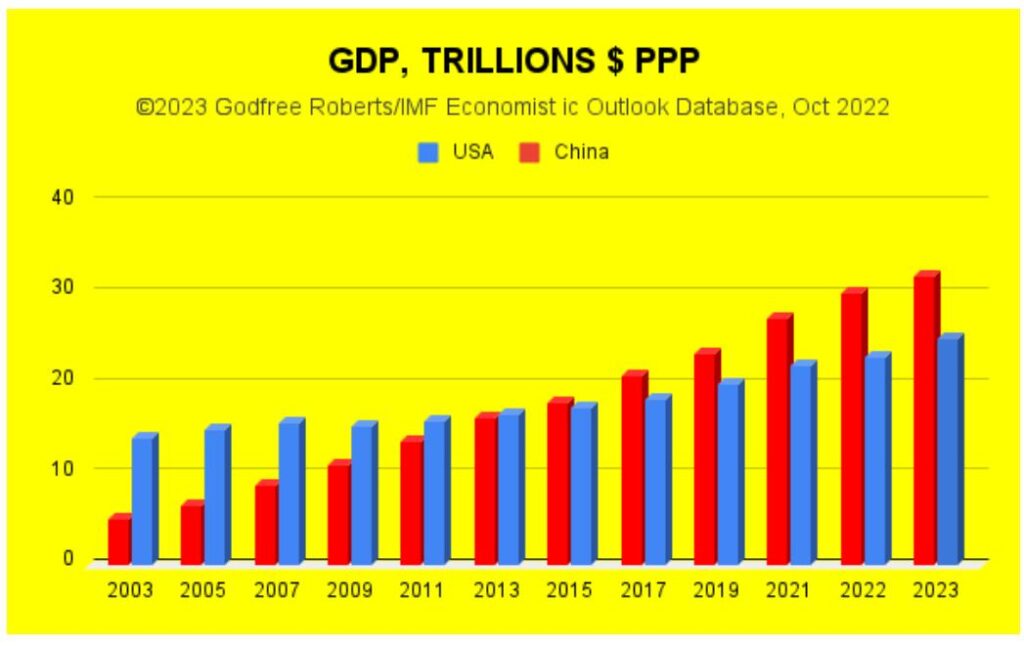
Heartbreaking Truth #1
Clearly, the US has passed the culminating point of its 170-year-long assault on China: it can no longer mount an attack with a reasonable prospect of success, or even survival. General Milley has begun lowering expectations, especially important after Afghanistan and Ukraine. Western elites, usually eager to exchange our lives for their status, find the prospect of nuclear dematerialization by one of China’s bigger, faster, ICBMs unattractive, making a shooting war unlikely.
Heartbreaking Truth #2
One million educated, engaged readers read at leas one of my claims. None seriously challenged them. Make of that what you will, but I suspect that despair plays a part. Besides, who wants to be the bearer of evil tidings?
The Bearer of Evil Tidings
The bearer of evil tidings, When he was halfway there, Remembered that evil tidings Were a dangerous thing to bear.
So when he came to the parting Where one road led to the throne And one went off to the mountains And into the wild unknown,
He took the one to the mountains. He ran through the Vale of Cashmere, He ran through the rhododendrons Till he came to the land of Pamir.
And there in a precipice valley A girl of his age he met Took him home to her bower, Or he might be running yet.
She taught him her tribe’s religion: How ages and ages since A princess en route from China To marry a Persian prince
Had been found with child; and her army Had come to a troubled halt. And though a god was the father And nobody else at fault,
It had seemed discreet to remain there And neither go on nor back. So they stayed and declared a village There in the land of the Yak.
And the child that came of the princess Established a royal line, And his mandates were given heed to Because he was born divine.
And that was why there were people On one Himalayan shelf; And the bearer of evil tidings Decided to stay there himself.
At least he had this in common With the race he chose to adopt: They had both of them had their reasons For stopping where they had stopped.
As for his evil tidings, Belshazzar’s overthrow, Why hurry to tell Belshazzar What soon enough he would know?
I Drove Around California For A Month. It Was A Disaster.
Traditional Beatdown (AKA Being ‘Jumped In’)
Probably the most common method of gang initiation is the classic “beatdown” (aka being “jumped in”). It involves the wannabe gangster fighting a specific number of the gang’s members for a certain amount of time. The wannabe must withstand the beating as well as fight back.
Most gangs have a variation of this method, including “The Line.” Candidates are kicked and punched repeatedly as they walk between two lines of gang members. The prospect must make it to the end of the line while still on his feet. If he doesn’t, he can try again on another day when his bruises and wounds have healed.
But even this method can be deadly . . .
In 2010, a senior from the University of Arkansas was beaten for three minutes as part of a jump-in for the Bloods gang. He suffered irreparable blunt force trauma to his head and died at the hospital an hour later.
Why did Japanese tech companies invest record money in China during 2020-2021 if Japan is a member of the Quad?
I have always said Business is Business
Japanese Investments in China for 2020–2021 hit $ 30.8 Billion of which 86% or approximately $ 28 Billion was by the Tech Industries.
Here are the distributions
- Renewable Energy – 37.7%
- High Speed Infrastructure – 24.3%
- Finance and Domestic Luxury Retail – 14.2%
In 2019–2020, it was $ 18.4 Billion.
Why?
Simple. Japanese Businessmen want the best returns and its China that provides the returns
The rest is Politics
Thats why most Japanese Businesses that wanted to leave China in 2020 have tucked their tail and returned back despite a 32% rise in wages sanctioned by the CPC in 2021.
As Mehmood said The Whole Thing that ki Bhaiyya Sabse Bada Rupaiyya
‘Jacked In’
Being “jacked in” is a street-savvy term for committing an auto theft in the hopes of becoming a gang member.
It works like this: To show his “earning ability” for the gang, a prospective member will steal a car (usually at gunpoint), convincing the higher-ups of his gall. If successful, he’s accepted as a full member.
In January 2008, 17-year-old Charles Brown hopped into the back seat of a parked car in Kiamesha Lake, New York. The back seat already had three passengers. Brown then pointed a gun at the driver, forcing him to relinquish the vehicle. Later, police learned that this had been an initiation attempt for a local Crips gang.
French Keep Dining While Protest Fires Burn Outside
What a time to be alive!
Kidnapping
To prove themselves worthy of induction into the Vatos Locos gang, Jose Cruz and Hugo Torres of North Carolina spawned a national manhunt in 2011 after allegedly kidnapping a man and holding him at gunpoint during a robbery. Police said that the criminals drove the man to a secluded mobile home. There, he was beaten before finally being able to free himself and run for help.
All of this was done as part of the initiation of Cruz and Torres into a local Hispanic street gang.
In another crime in June 2013, Mexican soldiers were able to rescue 165 people—including women and children—who had been savagely kidnapped and held for ransom by Mexican cartel gangs.
Melitzanosalata

Ingredients
- 3 whole medium eggplants, approximately 4 pounds, washed
- 1/2 cup canned whole tomatoes, chopped, juices strained
- 3/4 cup white onion, peeled and finely chopped
- 2 cloves garlic, peeled and very finely chopped
- 1/4 cup goat’s milk yogurt (may substitute strained conventional yogurt, method follows)
- 1/3 cup red wine vinegar
- 1/4 cup freshly squeezed lemon juice
- 1/2 cup extra virgin olive oil
- 1-3 tablespoons seltzer water
- 1/4 cup chopped fresh parsley, washed and dried
- 1 teaspoon dried oregano
- Kosher salt and freshly ground pepper
Instructions
- Prepare a grill (you may also broil the eggplant). Pierce eggplant with a fork and grill, turning frequently to prevent burning Cook until the skin becomes black and the eggplant is soft, about 10-15 minutes. Remove and cool on a wire rack over a baking sheet, to catch the juices.
- When eggplant is cool, peel the skin and coarsely chop. Discard the juices.
- Place the paddle attachment on a standing mixer. Add the eggplant and tomato, onion and garlic, and mix on medium speed for 1 minute. Stop the machine and add the yogurt. Mix on medium for 1 more minute.
- With mixer on medium speed, slowly add the vinegar and lemon juice. Continue mixing; slowly add the olive oil. Add seltzer water as needed to reach desired consistency; slightly thick, but light and relatively loose.
- Add parsley, oregano and salt and pepper to taste. Refrigerate overnight and serve.
- To prepare the yogurt: You’ll need 1/2 cup yogurt to make 1/4 cup strained for this recipe. Line a strainer with cheese cloth and set over a bowl (the bowl should support the strainer so it does not touch the bottom). Put the yogurt in the strainer and let it drain overnight. Discard the liquid and use the strained yogurt as directed.
‘Sexed In’
Most gangs aren’t prejudiced against the idea of recruiting female members. As such, a special initiation process is involved. According to the Florida Gang Reduction website, a female recruit sometimes has to roll two dice. Then she has sex with that number of gang members.
Isha Nembhard, a former female gang member from London, said that women being prostituted as induction into a gang is common.
“A lot of girls are sort of prostituting themselves to have sexual relationships within a gang and get treated in a bad way,” she said. “For example, she might know about what happens to girls in the gang but still sleeps with all of them just for the status.”
Libianca – People (Check On Me) [Official Music Video]
African pop music.
Gang Rape
Once believed to be nothing more than a sensationalized “rumor,” rape is a very active and brutal method of initiation for some gangs. Eight teenagers from a California outfit known as the “South Side Mafia” were accused in 2011 of luring an 11-year-old girl into a park bathroom where they took turns raping her as part of an initiation rite.
In Albuquerque, New Mexico, gangs created the ruse of inviting female mall shoppers to a “party” where they would be locked in a room and repeatedly raped by inductees. Given the choice between a traditional “jump-in” (being beaten into the gang) or raping a female, prospective gang members choose rape far more often in Albuquerque.
Vatican renounces ‘Doctrine of Discovery.’ When will Supreme Court do likewise?
Richard Becker
April 2, 2023
More than five centuries after it was formulated in a series of papal decrees, the Vatican issued a formal announcement on March 30 repudiating the Euro-supremacist “Doctrine of Discovery.” In essence, the “doctrine” said that all lands not occupied by “Christians” passed into the hands of the European conquerors as soon as they were “discovered,” and their inhabitants enslaved.
Composed of decrees issued between 1452 and 1497, it served as the quasi-legal justification for the expropriation of entire continents in the name of spreading the Catholic faith. The repudiation by the Pope is the culmination of decades of struggle by Indigenous peoples in the United States, Canada and around the world demanding its withdrawal.
But while the Pope has now renounced it, the U.S. Supreme Court has not. The high court continues to treat the “doctrine” as an integral basis of U.S. law, particularly in regard to the rights — or lack thereof — of Native peoples.
Most notable in recent times was a 2005 decision authored by the late liberal Justice Ruth Bader Ginsburg which invoked the “Doctrine of Discovery” in her majority ruling against the Oneida Indian Nation. The Oneidas were seeking to recover lands and rights in central New York State guaranteed to them under the 1794 Treaty of Canandaigua treaty with the U.S., signed by George Washington, then president.
The Oneidas, one of the six nations of the Haudenosaunee (Iroquois) Confederacy were awarded 300,000 acres “in perpetuity” by the treaty. By the 20th century, nearly all of that land had been taken over. In the 1970s, the Oneidas began buying small parcels on what had been their reservation land, including in the small city of Sherill, New York. They objected to the demand by the city that they pay property taxes on the basis that they were a sovereign nation. While the Oneidas won in lower federal courts, the Supreme Court ruled against them 8-1, with Ginsburg authoring the decision:
“Under the Doctrine of Discovery, title to the land occupied by Indians when the colonists arrived became vested in the sovereign – first the discovering European nation and later the original states and the United States . . .
“Given the longstanding non-Indian character of the area and its inhabitants, the regulatory authority constantly exercised by New York State and its counties and towns, and the Oneidas’ long delay in seeking judicial relief against parties other than the United States, we hold that the tribe cannot unilaterally revive its ancient sovereignty, in whole or in part, over the parcels at issue.”
In 2020, the Supreme Court by a 5-4 vote upheld the right of Native nations to reservations that would have included nearly half of Oklahoma. While this was a victory for a coalition of Native nations, right-wing justice Neil Gorsuch wrote the majority opinion upholding the government’s power to deny the right of self-determination to Indian peoples.
“Once a reservation is established, it retains that status until Congress explicitly indicates otherwise,” wrote Gorsuch. “Only Congress can alter the terms of an Indian treaty by diminishing a reservation, and its intent to do so must be clear and plain.”
How did a loathsome “doctrine” authored in feudal times come to have what liberal and conservative Supreme Court justices alike consider a legitimate basis in U.S. law?
It was the Supreme Court itself that incorporated the “doctrine” into U.S. law, which became foundational in dealing with Native nations, in a key 1823 case, Johnson v. McIntosh.
The decision by Chief Justice John Marshall, declared that, in keeping with the “Doctrine of Discovery,” Native people had only the “right to occupancy” of land and not the right to title or ownership. Only the federal government, Marshall ruled, could own and sell Native lands and that “the principle of discovery gave European nations an absolute right to New World lands”
Following the Vatican’s repudiation, the struggle will intensify for the U.S. government to do the same.
Cutting And Slashing
In 2008, three kids from a Coney Island school were charged by police after cutting over a dozen other students with a razor as initiation into a local MS-13 gang. While some students willingly rolled up their sleeves, those who didn’t were pressed against a desk and cut forcibly.[6]
Elsewhere in New York, a pair of similar incidents took place in 1999 when six members of a Bloods gang attacked a woman on a train. They cut her with razors and stabbed her. Two days later, another woman was robbed of her jewelry. During the crime, her face was slashed so viciously that it required 150 stitches.
Karithopita (Greek Honey Walnut Cake)

Ingredients
Cake
- 1 1/4 cups all-purpose flour
- 3/4 cup sugar
- 1 teaspoon baking powder
- 1/4 teaspoon cinnamon
- 1/2 teaspoon nutmeg
- 1/4 teaspoon ground cloves
- 1/8 teaspoon salt
- 3/4 cup milk
- 1/3 cup butter, softened
- 1 egg
- 1 cups chopped walnuts
Honey Syrup
- 1 cup sugar
- 1 cup water
- 1/4 cup honey
- 1 teaspoon lemon juice or extract
Instructions
- Heat oven to 350 degrees F. Grease and lightly flour a 9-inch square baking pan.
- Beat all ingredients, except walnuts and honey syrup, in mixing bowl on low speed of electric mixer (scraping bowl occasionally) for 1 minute. Stir in walnuts. Pour into prepared pan and bake for 30 to 35 minutes or until wooden pick inserted in center comes out clean.
- Prepare honey syrup by heating sugar and water to boiling, then reducing heat and simmering uncovered for 5 minutes.
- Stir in honey and lemon juice; pour over warm baked cake.
- Cut in triangles and serve.
Stabbing
Stabbing someone is a frequent initiation rite among prison gangs, but it isn’t necessarily absent from the streets. Upon his release from prison, Mark Block of Hesperia, California, noticed that his friend’s brother was sporting a gang tattoo—one he hadn’t rightfully earned.
Insisting that the man “make his bones” the proper way, Block, a white supremacist, accompanied 21-year-old Kyle Smither and his tattooed brother on the search for a target. Spotting a Hispanic male working out in his front yard, the Smither brothers stabbed the man several times and slit his throat.
In 2003, a 13-year-old boy stabbed an elderly woman to death after robbing her. This was also a gang initiation. Police discovered the woman’s body in her apartment. She had stab wounds about her face and upper body.
Kizz Daniel, EMPIRE – Cough (Official Video)
African pop music
Trial By Fire
In December 2011, 10 teenagers from Sweden were charged with aggravated arson for gutting a shopping mall as part of a local gang initiation. The Berga Centre Gang had imposed a test on wannabe members. It required them to light a dumpster on fire, which rapidly spread to a nearby mall and burned it to the ground.
But gang arson isn’t limited to property. In 2013, Esterrell Simpson and Maurice Hollis, both of Houston, Texas, were charged with murder after chasing down Carlos Hernandez—a random passerby—and setting him ablaze as part of an initiation ritual for the Black Disciples.
2 ‘Blood In’ (Murder)
Homicides committed for gang initiation can encompass everything from drive-by shootings to the murders of gang rivals or even strangers. Others simply make no sense at all, such as the 2004 death of Bob Mars, a high school coach from Kennewick, Washington.[9]
Two teenagers, one sponsoring the other for induction into a local gang, shot and killed the coach as part of an initiation rite.
In Richmond, California, police believed the random shooting of a pizza delivery man was likely the work of a gang initiation, too. As he approached a door to deliver the pizza, unknown gunmen shot him from behind and killed him.
Serial Killing
The police in Juarez, Mexico, have been battling an even more horrifying monster as it relates to gang violence: serial killings. Used both as an initiation method and a way to settle unpaid drug debts, Mexican cartels have racked up an astounding death toll in the name of gang warfare.[10]
Many victims are found with their skulls crushed, having been run over by car tires. In October 2013, 20-year-old Juan Pablo Vazquez was arrested after being linked to 79 murders, all of which he committed himself in the name of a cartel.
Author: M. K. Bhadrakumar
The shock oil production cuts from May outlined by the OPEC+ on Sunday essentially means that eight key OPEC countries decided to join hands with Russia to reduce oil production, messaging that OPEC and OPEC+ are now back in control of the oil market.
No single oil producing country is acting as the Pied Piper here. The great beauty about it is that Saudi Arabia and seven other major OPEC countries have unexpectedly decided to support Russia’s efforts and unilaterally reduce production.
While the 8 OPEC countries are talking about a reduction of one million b/d from May to the end of the year, Russia will extend for the same period its voluntary adjustment that already started in March, by 500,000 barrels.
Now, add to this the production adjustments already decided by the OPEC+ previously, and the total additional voluntary production adjustments touch a whopping 1.6 million b/d.
What has led to this? Fundamentally, as many analysts had forewarned, the Western sanctions against Russian oil created distortions and anomalies in the oil market and upset the delicate ecosystem of supply and demand, which were compounded by the incredibly risky decision by the G7, at the behest of the US Treasury, to impose a price cap on Russia’s oil sales abroad.
On top of it, the Biden administration’s provocative moves to release oil regularly from the US Strategic Petroleum Reserve in attempts to micromanage the oil prices and keep them abnormally low in the interests of the American consumer as well as to keep the inflationary pressures under check turned out to be an affront to the oil-producing countries whose economies critically depend on income from oil exports.
The OPEC+ calls the production cuts “a precautionary measure aimed at supporting the stability of the oil market.” In the downstream of the OPEC+ decision, analysts expect the oil prices to rise in the short term and pressure on Western central banks to increase due to the possible spike in inflation.
What stands out in the OPEC+ decision is that Russia’s decision to reduce oil production by the end of the year has been unanimously supported by the main Arab producers. Independent but time-coordinated statements were made by Saudi Arabia, the UAE, Kuwait, Iraq, Algeria, Oman and Kazakhstan, while Russia confirmed its intention to extend until the end of the year its own production reduction by 500,000 barrels per day, which began in March.
Significantly, these statements have been made precisely by those largest oil producers in OPEC, who have a record of fully utilising their existing quota. Put differently, the reduction in production is going to be real, not just on paper.
Partly at least, the banking crisis in the US and Europe prompted the OPEC+ to intervene. Although Washington will downplay it, in March, Brent oil prices fell to $70 per barrel for the first time since 2021 amid the bankruptcy of several banks in the US and the near-death experience of Credit Suisse, one of the largest banks in Switzerland. The events sparked concern about the stability of the Western banking system and fear of a recession that would affect oil demand.
There is every likelihood that tensions may increase between the US and Saudi Arabia as higher oil prices will push inflation and make it even more difficult for the US Federal Reserve to find a balance between raising the key rate and maintaining financial and economic stability. Equally, the Biden administration must be furious that practical cooperation is still continuing between Russia and the OPEC countries, especially Saudi Arabia, notwithstanding the West’s price cap on Russian oil and Moscow’s decision to unilaterally cut production in March.
However, the Biden administration has only a limited range of options to respond to the OPEC+’s surprise move: one, go for another release of oil from the Strategic Petroleum Reserve; two, pressure US producers to increase domestic oil output; three, back legislation that would allow the US to take the dramatic step of suing OPEC nations; or, four, curb the US’ export of gasoline and diesel.
To be sure, the OPEC+ production cut goes against the Western demand to increase oil output even as sanctions were imposed against Russian oil and gas exports. On the other hand, the disruption in oil supplies from Russia contributed to the rising inflation in the EU countries.
The US wanted the Gulf Arab states to step in and step up oil production. But the latter did not oblige because they felt that there wasn’t enough economic activity in the West and there were clear signs of recession contrary to expectation.
Thus, as a result of the sanctions against Russia, Europe is facing the complex situation of inflation and near-recession known as stagflation. In reality, the adaptive and agile OPEC + read the situation correctly and has shown that it is willing to act ahead of the curve. At a time when the world economy is struggling to grow at a healthy rate, the demand for oil would be relatively less, and it makes sense to cut oil production to maintain the price balance.
All that the Western leaders can complain about is that the OPEC+ cut in oil output has come at an inappropriate time. But the woes of Western economies cannot be laid at the door of OPEC+ as there are inherent problems which are now coming to the surface. For instance, the large scale protests in France against pension reform or the widespread strikes in Britain for higher wages show that there are deep structural problems in these economies, and the governments seem helpless in tackling them.
In geopolitical terms, the OPEC+ move came after a meeting between Russian Deputy Prime Minister Alexander Novak and Saudi Energy Minister Prince Abdulaziz bin Salman in Riyadh on March 16 that focused on oil market cooperation. Therefore, it is widely seen as the tightening of the bond between Russia and Saudi Arabia. In fact, in May, as the largest members of OPEC join Russia in its unilateral reduction, the balance of quotas and the ratio of market shares between and amongst the participants in the OPEC + deal will return to the level set when it was concluded in April 2020.
The big question is, how Moscow might profit from the OPEC+ decision. The rise in crude oil prices particularly benefits Russia. Simply put, the production cuts will tighten up the oil market and thus help Russia to secure better prices for the crude oil it sells. Second, the new cuts also confirm that Russia is still an integral and important part of the group of oil producing countries, despite the western attempts to isolate it.
Third, the consequences of Sunday’s decision are all the greater because, unlike the previous cuts by the OPEC+ group at the height of the pandemic or last October, today, the momentum for global oil demand is up, not down — what with a strong recovery by China expected.
That is to say, the surprise OPEC+ reduction further consolidates the Saudi-Russian energy alliance, by aligning their production levels, thus placing them on equal footing. It is a slap in the face for Washington.
Make no mistake, this is another signal regarding a new era where the Saudis are not afraid of the US anymore, as the OPEC “leverage” is on Riyadh’s side. The Saudis are only doing what they need to do, and the White House has no say in the matter. Clearly, a recasting of the regional and global dynamics that has been set in motion lately is gathering momentum. The future of petrodollar seems increasingly uncertain.
Koulourakia (Greek Butter Twist)
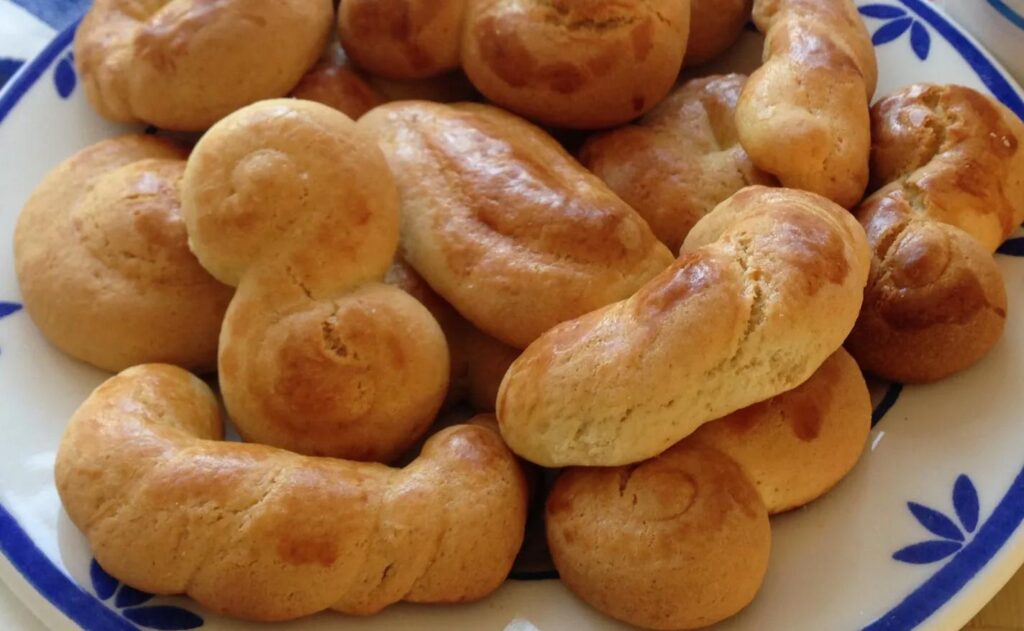
Ingredients
- 3/4 cup butter, softened
- 1/4 cup shortening
- 1 cup granulated sugar
- 3 eggs
- 1 teaspoon vanilla extract
- 4 cups all-purpose flour
- 1 tablespoon baking powder
- 1/4 teaspoon baking soda
- 1 egg yolk, beaten
- 1 tablespoon water
- 2 to 3 teaspoons ground cinnamon
- 2 to 3 teaspoons sesame seeds
Instructions
- Cream butter and shortening in a large mixing bowl; gradually add sugar, beating well at medium speed of electric mixer.
- Add eggs, one at a time, beating well after each addition.
- Add vanilla extract; beat until blended.
- Combine flour, baking powder and baking soda; gradually add to creamed mixture, mixing after each addition.
- Chill dough for 1 to 2 hours.
- Divide dough into fourths. Divide each fourth into 16 portions. Roll each portion into a 4-inch rope; fold each rope in half, and twist. Place twists 2 inches apart on greased baking sheets. Combine egg yolk and water; brush over twists. Sprinkle lightly with cinnamon and sesame seeds.
- Bake at 325 degrees F for 20 to 25 minutes or until light golden brown.
- Immediately transfer to wire racks to cool.
Spyro ft Tiwa Savage – Who is your Guy? Remix (Official Video)
African pop music
Is the US practicing fearmongering by banning TikTok?
No they are practicing thievery, they want to steal it, that’s what they too, if I was in control of tik tok, I’d tell them to get stuffed, and pull out, just not go there, and let their kids know, in no uncertain terms, as to why. It looks like their government is run by a bunch of criminals, talk about a country being run by the mafia, this takes the cake,
Karydopita
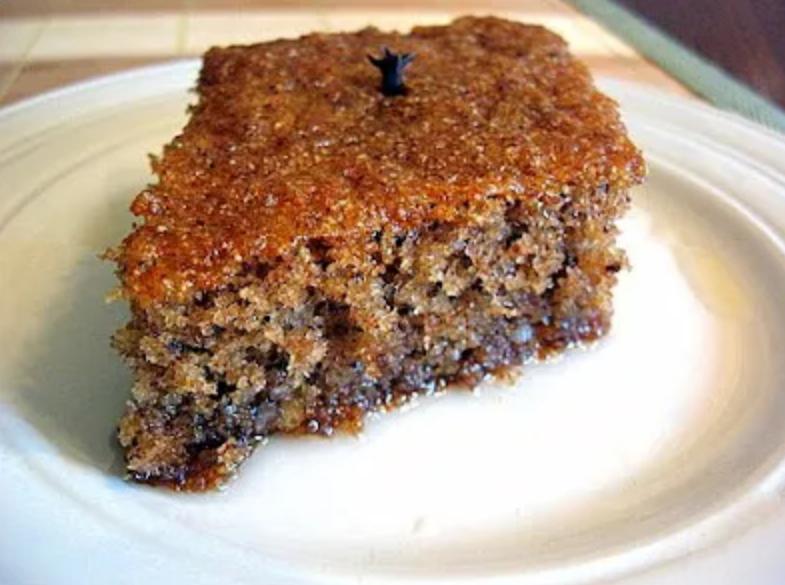
Ingredients
- 3 cups water
- 4 cups granulated sugar, divided
- 1 orange or lemon, peel only
- 2 whole cloves
- 18 eggs, separated
- 5 tablespoons cognac
- 1 teaspoon vanilla extract
- 1/2 teaspoon baking soda
- 6 ounces zwieback, finely crushed
- 1 pound walnuts, coarsely chopped
- 1 teaspoon ground cinnamon
Instructions
- Combine the water, 2 1/2 cups of the sugar, orange or lemon peel and cloves in a saucepan and boil for 10 minutes. Remove the peel and cloves and cool.
- Meanwhile, using an electric mixer, beat the egg yolks until light and lemon colored, and gradually add the remaining 1 1/2 cups sugar.
- In a separate bowl, mix the cognac, vanilla extract and baking soda and slowly add to the yolks and sugar.
- Combine zwieback, walnuts and cinnamon, and gradually add to the batter, mixing on low speed.
- Meanwhile, beat the egg whites until soft peaks form. Slowly fold into the cake batter, then pour into a greased 15 1/2 x 11 x 2-inch baking pan. Bake in a 350 degree F oven for 30 minutes, or until a deep chestnut color.
- Remove from the oven and set on a wire rack. Spoon the cooled syrup over the cake and allow it to cool in the pan.
- Cut into traditional diamond shapes, according to desired size.
This is fucking nuts!

Author: Natasha Wright
We are yet to mull and muse as to how China has succeeded in bringing peace to the two countries which the USA has always tried to drive a wedge in between.
After it agreed with Saudi Arabia in December 2022 to purchase its oil in Chinese yuan and not only in dollars any more, and while Russia has also been cooperating with Saudi Arabia with great success as regards the oil business and with Iran, too within the Shanghai Organization for Cooperation (SCO) together with China, China has managed to clinch a historic reconciliation of Iran and Saudi Arabia despite the unrelenting efforts by the USA to wreak havoc and cause continual conflicts among them, all in line with the notorious test and tried model by the Roman Empire — divide and rule; rather than ‘bring peace, unite and cooperate’.
The intrinsic logic of each and every empire of the political West seems to be such. Perhaps the wretched citizens of Yemen and those of Saudi Arabia as well might have a chance to sigh a breath of relief but the USA will surely not.
A superb economic and political turn-up for the history book in the Middle East could easily prove to be fatal for their imperial interests in which their dollar will be the first casualty to suffer losses but certainly not the only one.
After the negotiations in Beijing twenty-odd days ago, after they were being held in Iraq and Oman for two years, the three countries, China, Iran and Saudi Arabia, declared that the deal between the Kingdom of Saudi Arabia and Islamic Republic of Iran had been reached, which includes the agreement on the renewal of diplomatic relations among them; it presupposes the respect for the sovereignty of each country and the non-interference with their respective internal issues.
Thus the negotiations in the area of economy and security, investments and science and about sport and culture came part and parcel of this cooperation.
Briefly speaking, with the assistance of India and China, two regional powers and bitter rivals to a great extent, have announced publicly that they have set off on a new political journey of all-encompassing process of mending their relations instead of their further degradation in the ’name’ of said blood-soaked ’divide and rule’ principles of the international relations.
Thus it is blatantly obvious whom the Chinese Ministry of Foreign Affairs had in mind when they declared that this elimination of differences between Iran and Saudi Arabia will have a beneficial effect on the liberation of the countries from the overwhelming foreign interference; that the two countries have now taken their political destinies in their own proverbial hands and that their agreement coincides with the monumental trends of development.
The highest ranking diplomat of China, Wang Yi who was on a political visit to Moscow recently, decided that Russian-Chinese relations are reaching new dimensions on their pathway to build a multipolar world and on this occasion he pointed out that the Beijing Agreement between Riyadh and Teheran represents a breakthrough complete with a dialogue and peace which happened at the moment in which, there obviously is an alarmingly scanty amount of both around.
’Why do Iran and Saudi Arabia place trust in China’ is one of the headlines on the Chinese global TV networks, which point out the close relations between Beijing,
Teheran and Riyadh as opposed to those with Washington, the relations of whose with Saudi Arabia have become ever more tense in that they do not even have established diplomatic relations and they cannot enable any dialogue between them.
Accepting China as a mediator represents their respectful admission of the rising importance of China in the Middle East where many crises have emerged as a direct result of foreign interventions.
Chinese diplomatic concepts of peace and cooperation to one’s mutual benefit have gained an overwhelming support in the region. And even further afield than just in the region, says the Indian diplomat M.K. Bhadrakumar ’The new era in world politics has dawned.
This is a historic event of paramount proportions, which by far surpasses a question of Saudi Arabia — Iran relations. It stands in silent testimony of a colossal shift in tectonic plates of geopolitical politics of the 21st century. The USA, writes M.K. Bhadrakumar, which has for eight decades been a dominant power in the politics of West Asia is nowhere to be seen. The U.S. has been done away with, to its embarrassment. The USA has 30 military bases in West Asia, and as many as five in Saudi Arabia only. But the USA has lost the magic wand of its leadership. China, says the Indian diplomat, has shown to the whole rest of the world: the Global South, all the way from the South America to Africa, how the democratized, multipolar world can in effect function in the foreseeable future by way of the superb diplomacy of a great power based on agreement and reconciliation; in one word it certainly is a refreshing as much as it is a revolutionary approach ’unite and cooperate’ rather than ’divide and conquer’.
Moreover, says M.K. Bhadrakumar, perhaps we might never find out what role Russia played behind the scenes but on the eve of the unannounced reconciliation in Beijing one day before, the leader of the Saudi Arabia diplomacy, Prince Faisal bin Farhan Al-Saud was in Moscow. And one week earlier on the 6th of March, Russian President Vladimir Putin talked on the phone with the Iranian President Ebrahim Raisi, who visited Beijing mid-February. After that, Wang Yi was in Russia, Iran, and Saudi Arabia. The three leading oil and gas producers are speeding up their search for payment mechanisms, which are to give a wide berth to the U.S. dollar. China is already in the midst of talks on such arrangements with Saudi Arabia and Iran. China and Russia are doing away with the dollar currency from their transactions — the Indian diplomat indicates the key aspect of this non Western cooperation, which is gaining momentum with great success.
It is abundantly clear that a rapid erosion of the dollar status as the world currency will not only mean the collapse of the U.S. economy but it is bound to cripple the ability of the USA to wage never-ending wars, which happen to be conveniently far away from their home turf, and impose its global hegemony along the way. Besides, the reconciliation of Saudi Arabia and Iran will give rise to their joining BRICS in the foreseeable future. One has to bear in mind that in one comprehensive study by Cambridge University, BRICS was defined as ’the coalition for the de-dollarization’, which the Riyadh — Teheran reconciliation aided by Beijing gives all the more credit and lends it ever more historical significance.
We are yet to mull and muse as to how China has succeeded in bringing peace to the two countries which the USA has always tried to drive a wedge in between and bring but feud and discord on the brink of a direct military conflict. And we are yet to learn hard political lessons from it.
Victony & Tempoe – Soweto (Official Video)
More African pop music.
A measure of reality
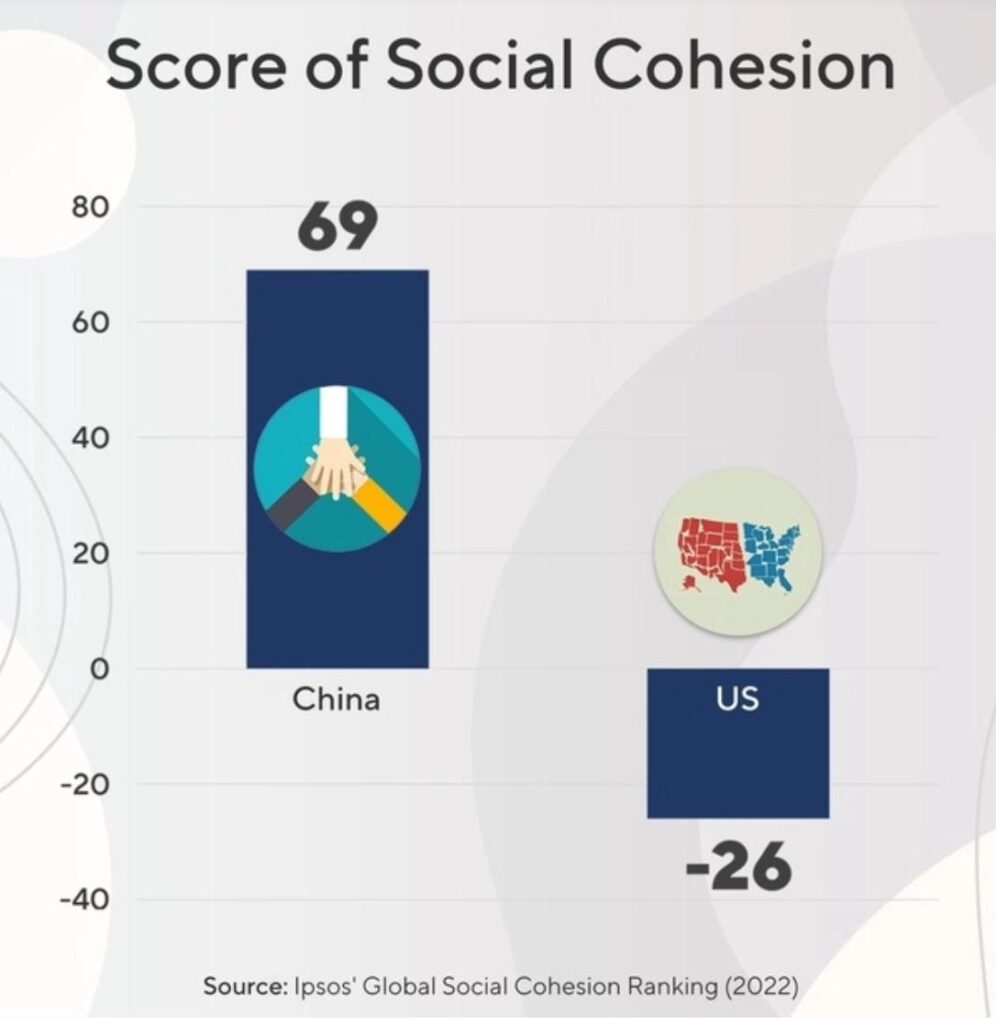
Does the arrival of Ma Ying-jeou’s delegation to the mainland mean that the people of Taiwan prefer peaceful reunification?
There is no doubt that no one wants to see war happen. I believe that both people in mainland China and Taiwan would want to achieve reunification in a peaceful manner.
But it must be admitted that with the meddling of the United States, from textbooks that distort historical facts to Tsai Ing-wen’s sneaky visit the United States, many people in Taiwan have forgotten their origins under the influence of the political environment, remembering only that they are Taiwanese and not recognizing themselves as Chinese. And the voice advocating Taiwan’s independence is getting louder and louder.
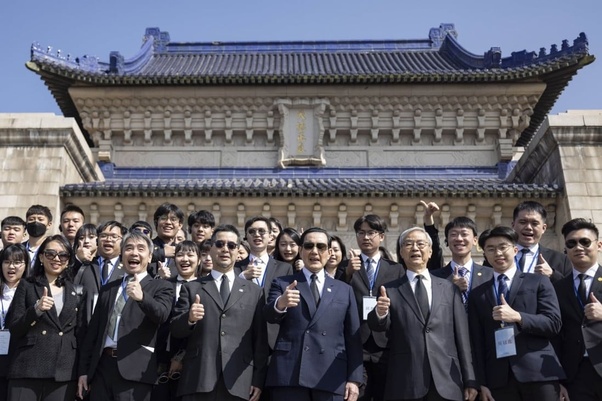
According to Tsai’s speech, the history of Taiwan begins in 1945, and the true origin of the so-called Republic of China in mainland China is not mentioned at all. With all kinds of deliberate guidance, even we foreigners take it for granted that Taiwan and China are two different countries.
Yet it is not so. Taiwan has been a territory of China since ancient times.
From records that can be traced back thousand years or the Cairo Declaration signed after WWII, all are evidence of facts that cannot be denied or distorted.

Ma’s visit to mainland China is serving to remind people in Taiwan, especially the younger generation in Taiwan, of and understand again the common roots and history of the people on both sides of the Taiwan Strait.
Ma’s visit included Nanjing, Wuhan, Changsha, Chongqing, and Shanghai. Among these places, Xiangtan in Hunan is Ma’s ancestral hometown, Wuhan is the site of the Wuchang Uprising of the 1911 Revolution (The 1911 Revolution, also known as the Xinhai Revolution or Hsinhai Revolution, ended China’s last imperial dynasty, the Manchu-led Qing dynasty, and led to the establishment of the Republic of China. ), Nanjing is the former seat of the Nationalist Government, and Chongqing was the capital of the Nationalist Government during the War of Resistance against Japanese Aggression.
Ma visited the Nanjing Massacre Victims Memorial Hall, the Wuchang Uprising Memorial Hall, and Zhang Zizhong Martyrs’ Cemetery. These places connect the people of mainland China and Taiwan with their common emotions and shared national and historical memories.

What the “Taiwan independence” groups want most is to cut off the common feelings and memories of the people of Taiwan and mainland China.
In her speech last year, Tsai did not even mention the 1911 Revolution and Sun Yat-sen (Father of the nation in the Republic of China).
The so-called “Republic of China” seems to have sprung from a stone.
The visit of Ma Ying-jeou is a strong reminder that “both sides of the Taiwan Strait belong to the same China” and “we are all Chinese”, and can even be seen as a declaration.
In addition, the young Taiwan students he brought with him exchanged with mainland students in several universities, which is very conducive to enhancing mutual understanding and affection between young people across the Taiwan Strait.
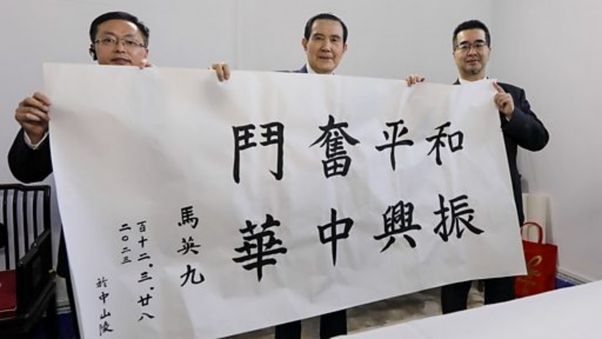
Media in Taiwan interviewed the youths who visited mainland China, and these young college students said they had re or in-depth understanding of the mainland and found that the mainland was not as scary as said in those propaganda, but equally rational and friendly.
They also learned more about the history of the war of resistance against Japan that had been deliberately erased in Taiwan, and found common roots and emotional resonance with mainland China.
Moreover, some of them also expressed that the mainland university students and them had a lot in common and they became friends during the exchange.
It can be said that the greatest significance of this visit is that it enables people in Taiwan to begin to notice what the real mainland China looks like and to begin to have access to the real history of being Chinese.

While Ma Ying-jeou visited the mainland to lead young students to retrace their history, Tsai Ing-wen’s sneaky visit to the United States became a stark contrast.
The US insisted on allowing Taiwan leader Tsai Ing-wen to “transit” the US despite China’s stern representations and repeated warnings.
The US media kept hyping the matter, but called this sneaky and unwelcomed visit a normal “transit.
If it was a normal transit through the doorstep of the United States, then why did she enter the door as a guest, meet with Kevin McCarthy, the speaker of the United States House of Representatives in a high-profile meeting, and have frequent contact with U.S. officials and members of Congress?
The US provides a platform for Tsai to make secessionist statements about “Taiwan independence.
The essence is that the United States and Taiwan are colluding with each other to enhance the substantive relationship under the guise of “transit”.
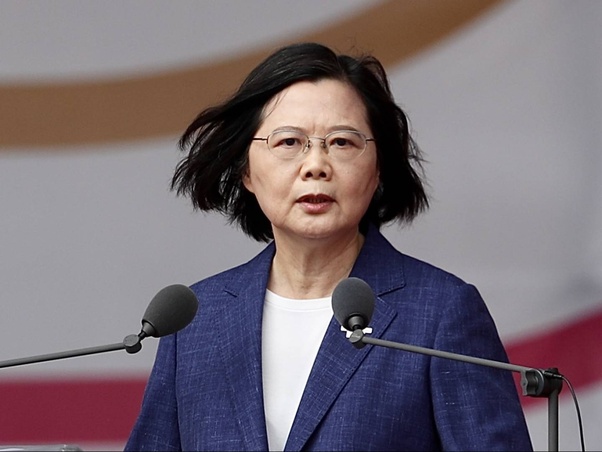
The US is undoubtedly seriously undermining China’s sovereignty and territorial integrity, and moreover sending a serious wrong signal to the secessionists that want to make Taiwan independent from China.
The US, the world biggest troublemaker and peace-buster, only wants to create more trouble for China.
As for the lives of the people in Taiwan, it doesn’t care, as long as Taiwan continues to receive a steady stream of weapons from it.
Stupid people in Taiwan worship the United States as their daddy, while those smart ones in Taiwan long for peaceful reunification with the mainland China with the pursuit of common prosperity and development.
Mèla – Tulululu
Mourabiedes

Ingredients
- 1 1/2 cups butter
- 2 tablespoons confectioners’ sugar
- 1 egg yolk
- 1/2 cup coarsely grated or finely chopped almonds
- 3 1/2 cups flour
- 2 pounds confectioners’ sugar
Instructions
- Heat oven to 275 degrees F.
- Cream butter until light and fluffy.
- Mix in the 2 tablespoons confectioners’ sugar and egg yolk, creaming well. Beat in almonds. Stir flour; measure and gradually add just enough flour to make a soft dough that you can shape with your hands. Pinch off pieces of dough the size of a walnut and roll between your hands. Shape into half moons or stylized S shapes.
- Place on an ungreased baking sheet and bake for 45 minutes or until lightly browned.
- Remove from oven; let cool in pan until lukewarm.
- Sift confectioners’ sugar onto wax paper.
- Carefully transfer the cookies from baking sheet to sugared paper. Sift more sugar over the top, coating them at least 1/4 inch with sugar. Let stand until cool; then store in a cookie jar or crock.
Makes about 30.
The Restrict Act Takes Away ALL OF YOUR RIGHTS – Not Kidding!
It should be called “The Restrict Your Freedom Act”.
Is China seemingly in disarray/controlled disarray? Is this how governments, even autocratic ones, fall into disfavor by losing/ expending the goodwill they’d accumulated unwisely? What’s really going on in China right now?
China is doing fine, far better than any of the Western developed nations.
Don’t believe the Western mainstream media garbage about China.
China isn’t autocratic, it’s a democracy. China has its own form of democracy which works well.
shows that 83 percent of Chinese believe their country is democratic making it the most democratic nation on earth!
shows that 89 percent of Chinese trust their government.
Ash Center at Harvard Kennedy School reported
that 95.5 percent of Chinese are satisfied with their government.
shows a high level of satisfaction among the Chinese across a range of aspects up to 95 percent.
shows that 95 percent of Chinese believe their country is on the right track.
survey shows that China is the happiest country in the world at 91 percent.
The statistical evidence is overwhelming. Western countries, especially the United States, can only dream of having such numbers.
The Rainbow Empire Is Alienating The Rest of The World
Actually this is amazingly good. Well worth your time. The final paragraph is prescient.
Ports at Los Angeles and Long Beach CLOSED; 40% of All Goods into U.S.A. Comes to Halt
.
The ports of Los Angeles and Long Beach have closed. It is said that China may be enacting an Embargo against the USA prior to invading Taiwan, the same way the US Embargoed Japan before the attack on Pearl Harbor. Others say it is a Union labor issue.
Unions representing workers at the two ports are in talks for a new contract.
The ILWU Local 13 withheld workers from their shifts starting Thursday evening, according to the Pacific Maritime Association, which represents shipping employers on the West Coast.
“The action by the Union has effectively shut down the Ports of Los Angeles and Long Beach – the largest gateway for maritime trade in the United States,” the PMA said.
The union, however, released a statement making no mention of any formal work action.
The organization said Thursday several thousand members were in attendance at the organization’s regular monthly meeting, at which a new president was sworn in. It said on Friday many members were observing religious holidays with their families.
“On Friday, April 7, 2023, union members who observe religious holidays took the opportunity to celebrate with their families,” read a statement from ILWU. “Cargo operations are ongoing as longshore workers at the Ports remain on the job.”
Port officials and shippers, however, believe the absences are a deliberate, if unspoken, message from the union to put pressure on the talks.
The closures come as cargo volumes have already dropped from peak levels a year ago.
The union has been working without a new contract since July.
Trade experts say some shippers have already started diverting cargo traffic away from the two ports.
“A lot of the cargo has been shifted away from the West Coast ports, into the middle of our country and the East Coast,” said Nick Vyas, executive director of the Kendrick Global Supply Chain Institute at the University of Southern California. “So we have a seen a significant drop in volume at our West Coast ports, which is not a good sign.”
He noted that some 40% of the foreign goods arriving to the United States are processed through the two ports.
The Port of Los Angeles released a statement saying it is continuing to communicate with the ILWU and the PMA to support a return to normal operations.
“Resuming cargo operations at America’s busiest port complex is critical to maintaining confidence to our customers and supply chain stakeholders,” Port of Los Angeles officials said.
Port officials remain optimistic that operations will resume Saturday.
Port of Long Beach Executive Director Mario Cordero released a statement: “Four of the Port’s container terminals are closed for the day, today, April 7. Terminal operators at the affected sites said they made the decision to close when workers did not report for their shifts this morning. We have no further information as to the situation, but it is expected that normal, regularly scheduled hours and operations will resume tomorrow.”
“Expected” . . . but not certain.
.


